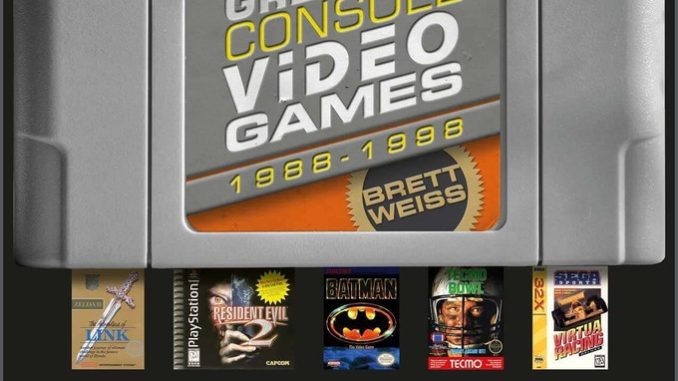
When Brett Weiss asked me to contribute to his upcoming book, The 100 Greatest Console Video Games 1988-1998, I was beyond honored. Little known fact- Brett Weiss is one of my biggest influences in game writing. Before I began my journey in The Minds Behind the Games, I was a games journalist for Examiner, NBC and ReviewFix and whenever Brett had a new book out, I loved to interview him. to say it lightly, I respect and admire him as a writer and a person. As the years have progressed, he’s written a foreword for my series and I’ve managed to contribute to a half dozen of his books.
This upcoming book, however, may, in fact, be the best. But don’t take my word for it.
Check out my essay in the upcoming book below and check out the project on Kickstarter today.
They say not to present your opinion when writing something of journalistic merit, but saying that NHL ’94 is the most influential and greatest hockey game of all time is not opinion. It’s a fact. That’s not to say there haven’t been amazing hockey games before its release, or after, but none have the legacy of NHL ’94.
Over 25 years since its initial release, NHL ’94 is still modded by homebrewers with updated rosters and ratings. Electronic Arts even released their own updated version of NHL ’94 for the 2021 season as a pre-order bonus for the PlayStation 4 and Xbox One versions of NHL 2021. That pretty much says it all. While later NHL games have added other amazing features to the gameplay mix over the years (NHL Faceoff ’97’s Icon passing and the introduction of the Skill Stick in NHL 08, for example), even those visually sexier games lack the accessibility and sheer fun factor of NHL ’94.
To understand why NHL ’94 is so special, you have to understand the genesis (pun intended) of the series. Without real players, NHL Hockey on the Sega Genesis/Mega Drive was a wonderful version of the sport. The top-down view, the sense of speed, the fun. It was the best hockey game ever released up until that point, even if it only featured the numbers of the real players, but not their names. The next year, NHLPA 93 hit the virtual ice, this time without an NHL license, but with real players. This changed everything. The game played pretty much the same and added the Tampa Bay Lightning and Ottawa Senators, making it a cartridge that featured the entire NHL.
While the absence of fighting will always dim the NHL ’94 legacy a bit (no game is perfect, after all), the game is special in part because it added a feature that forever changed the hockey video game genre—the one-timer. Allowing a player to shoot, as he accepted a pass, one of the coolest things done in a real hockey game, elevated EA’s product to never-before-seen levels. For the first time, even in pixelated 16-bit form, the game felt like the real thing. The players knew. The fans knew. This was the beginning of the NHL empire and a sign of what EA was capable of doing with every professional sport—and they did.
Sure, Madden and FIFA get all the love today—but how many games introduced players to a sport for the first time? Nothing against FIFA and Madden, but if you don’t like soccer and football, you’re probably not going to play them in video game form. No way. There are just too many rules in soccer, and football is even worse. The speed and fun of hockey, however, absolutely lends itself to the video game art form. While the recent games in the series are more realistic than ever (I’ll leave it up to you if that’s a good thing or a bad thing), NHL ’94 was a game that hardcore fans of the sport adored and casual fans or newbies could absolutely find themselves immersed in. Again, how many games can say that?
Simply put, NHL ’94 was a love letter to professional hockey. For someone like me, who grew up reading the yearly NHL almanac and who went on to cover professional hockey as a journalist, it was a way for an 11-year-old to see and feel how every player in the league played. From the hard snapshots of Al Iafrate to the smooth skating of Wayne Gretzky, NHL ’94 allowed you to connect to the sport in no other way prior. Still to this day, I know what my New York Islanders in the game are capable of—that Pierre Turgeon by himself can change the outcome of a game, but I’m so much better with Jeremy Roenick and the Blackhawks, especially if I’m playing someone who has some skills (insert laughter here).
In a day and age now, where even mediocre players are rated over a 75 in NHL 21, the original creators of the series had far bigger marbles and weren’t scared to rate players low. Just ask Dennis Vaske, the former Islanders defenseman, who’s rated a 38 in NHL ’94, or Tony Twist, the tough guy (forever immortalized in the Spawn comic book series as a villain) who is rated a 33 and can barely skate in the game but can check a cow off the ice. While arcane today, those player ratings got people thinking more about sports games than ever before. Some people still argue them today.
Igor Kuperman, the Winnipeg Jets’ Director of Hockey Information, created the ratings for NHLPA Hockey ’93 and NHL ’94. In an interview published on si.com, he spoke about the process.
“I had to rate players in 12 categories, such as accuracy, shot power, checking, passing ability and fighting, on a scale of zero to six,” he said. “I also had to figure out who was on the first power play, second power play, first penalty-killing unit and second penalty-killing unit.”
Michael Brook, who produced NHL Hockey, NHLPA Hockey ’93, and NHL’94, and designed NHL ’95, added that he “took Igor’s ratings as a guideline and converted them from a zero to six rating to a rating out of 100, using additional information and stats, and included a random factor.”
After the game was released, Kuperman got in a little trouble with Tie Domi. “He always grilled me why his NHL ’94 ratings were lower than Bob Probert’s,” he said.
In that same interview, Brook spoke a bit about the inspiration behind the series, which began with 1991’s NHL Hockey: “The idea was we were going to convert the Madden model to the NHL to play a hockey game…I grew up in Philadelphia in the 1970s, so, as you can imagine, I was a fan of the Broad Street Bullies. That actually had quite an influence on the game. If there was a brand of hockey I was trying to build into the game, it was more like the Flyers than the Soviet Olympic team.”
But away from its origins, the sexy one-timers, the full NHL license, and full team rosters and player ratings, NHL ’94 reigned supreme for another reason—it had a soul. Each team played like one. Each arena felt like home to the player. It didn’t need anything sensationalized from the video game world—anything that was “super” or “mega.” It was just a damn good hockey sim for the people that loved it most and a great game for anyone who wanted to know what all the fuss was about. If the game was a person, you could even say this: NHL ’94 wasn’t out to make any friends; it was out to create a fun and fluid game of hockey that presented the league as it was then, fast and fierce.
Even without fighting, NHL ’94 is one of the greatest sports games ever created and a game every player must experience before their game is over.
FUN FACT: After the release of NHL ’94, the NHL Players Association argued to have ratings of players changed so no player could be rated lower than 60.
WHY IT MADE THE LIST: Thanks in part to the innovation of the one-timer, as well as gameplay that holds up incredibly well, NHL ’94 is arguably the most beloved hockey video game ever released.
~ Patrick Hickey, Jr., author of The Minds Behind the Games book series
Check out the full book on Kickstarter, Here


Leave a Reply